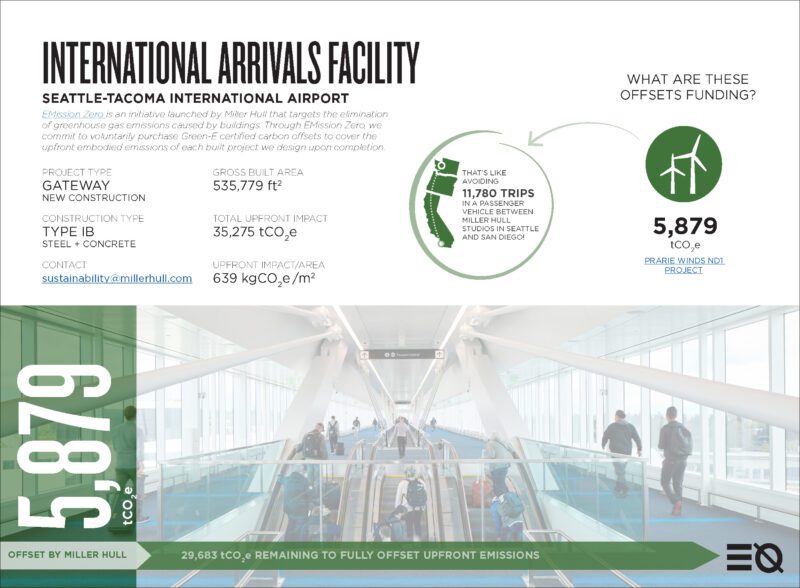Miller Hull
- Portfolio
- Approach
- News
Events
Posted September 22, 2025
- About
- Connect
Welcoming international passengers into the United States with an authentic Pacific Northwest sense of place
×- Client Port of Seattle
- Certifications LEED Silver
- Size 450,000 SF
- Completion 2020
- EMission Zero Offset 5,879 tCO2e
-
Map
International traffic continues to grow at SEA, increasing more than 45 percent since 2009, including 14 new intercontinental services over the past 10 years. To meet the needs of current passengers and encourage continued growth, the new International Arrivals Facility (IAF) increases the airport’s capacity for international travel, updates and improves the processing of arriving passengers and baggage and provides a world-class experience that makes SEA a preferred West Coast travel hub.
Utilizing one of the last available locations surrounding the airport, the IAF is key for the future development and passenger capacity of the airport. It is designed to complete the geometry of the existing site and is comprised of three components: a new 900-foot Pedestrian Walkway that connects to the existing South Satellite terminal, a new Sterile Corridor, which will allow international arrivals at 10 existing domestic gates and a new Arrivals Hall that will house baggage claim and U.S. Customs and Border Protection processing.
To create an authentic, memorable and preferred arrival experience for travelers connecting to domestic flights and those arriving to their final destination, the IAF welcomes passengers by celebrating the culture, heritage, natural beauty and pioneering spirit of the Pacific Northwest. Upon arrival, passengers deboarding at the South Satellite terminal are guided to the Pedestrian Walkway 85 feet off the ground that bridges the active runway. Enclosed with full-height glazing, the walkway provides ample daylight, as well as sweeping views of Mount Rainier and the Cascade and Olympic mountain ranges on a clear day.
Continuing on, travelers pass through a Douglas fir portal into the expansive Arrivals Hall engulfed by daylight and open to the baggage claim area below. The interior space encourages intuitive wayfinding through the undulating roof using building materials that express a northwest sense of place, including large aggregate terrazzo flooring, cedar wall panels and locally-based art installations.
Guiding passengers through baggage claim and U.S. Customs, travelers exit the hall and descend a 450-foot sloped walkway overlooking a forested lightwell that connects forest canopy to forest floor. A second Douglas fir portal frames an exterior cascading basalt water feature that signals the end of the arrival experience and leads passengers into the existing Gina Marie Lindsey Hall.
Led by Skidmore, Owings & Merrill in collaboration with Miller Hull, the design team is partnered with Clark Construction and working collaboratively with the Port of Seattle to complete the project using a Progressive Design-Build delivery method. Members of the design-build team, owner team and key consultants are collocated in a shared office within close proximity to the site, allowing all team members to have consistent, face-to-face collaboration and coordination.
Project Team
Local Architect: The Miller Hull Partnership, LLP
Design Architect & Architect of Record: Skidmore, Ownings & Merrill
Contractor: Clark ConstructionEMission Zero Offset
In 2022, Miller Hull offset 24,264 tCO2e (tons of carbon) of twelve projects as part of our recently launched EMission Zero initiative — a program announced in 2021 targeting the elimination of greenhouse gas emissions in the built environment. A major component of EMission Zero is Miller Hull’s commitment to voluntarily purchase Green-E certified carbon offsets to cover the embodied emissions of each built project upon completion.
-
Awards
-
Press
-
Prix Versailles Airports
2023 World Selection
AIA San Francisco
2023 Architecture Special Commendation for Technology Excellence
AIA Washington
2022 Civic Design | Merit Award
××
